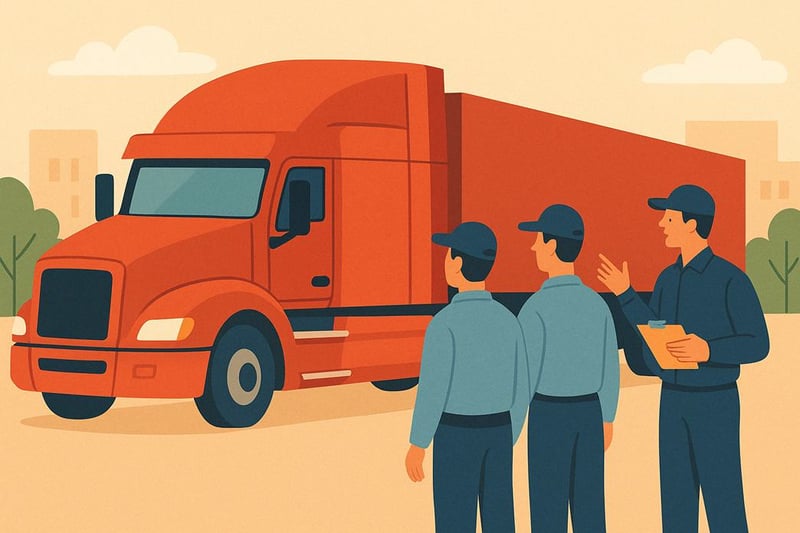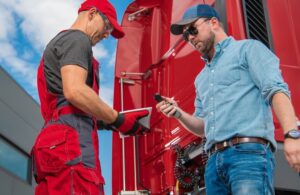From Onboarding to Behind-the-Wheel
This quick-start guide is for fleet managers, safety directors, and HR professionals who need to create or update an in-house CDL training program. It considers all Federal Motor Carrier Safety Administration (FMCSA) guidelines and provides insights and a real-world example of an organization using its procedure recommendations. With driver shortages on the rise and Entry-Level Driver Training (ELDT) compliance required, designing a strong CDL training framework is imperative and is becoming a financial necessity.
Background
To cope with driver shortages in the industry, organizations are looking for methods beyond the usual classroom-based CDL training and licensure model to improve and speed the process. Any changes must not sacrifice safety or compliance and must meet ELDT standards. As such, many employers are weighing e-learning vs classroom CDL training. Incorporating insights from a literature review, this report explores how online, self-paced CDL training can improve the licensing process, reach licensure more quickly, cut costs, and increase accessibility while maintaining compliance.
Why Create an In-House CDL Training Program?
- Control and Customization
In-house CDL programs allow fleets to tailor the curriculum, ensuring drivers are trained in company-specific safety policies, equipment standards, and operational procedures. Tailoring enables companies to train to their exact safety and operations standards, resulting in a much more effective transition of trainees from program graduation to position startup.
- Cost Savings
According to our literature review, traditional CDL schools can cost between $5,000 and $10,000 per trainee. By developing an internal training program, companies eliminate third-party tuition costs and travel and lodging reimbursements and minimize productivity losses that often occur due to in-person scheduling conflicts. Over time, this can lead to significant budget savings.
- Faster Onboarding:
According to American Trucking Associations (2023), hybrid training models that combine online theory instruction with local behind-the-wheel training can speed up the licensing process by up to 30%. Theory modules can be completed at the employee’s own pace, allowing quicker progression to hands-on driving.
- Retention:
Employees who go through internal training programs are statistically more likely to feel supported and connected to the overall mission and expectations of the company. Studies from major fleets like Anheuser-Busch suggest that in-house training helps reduce turnover by creating stronger cultural alignment and job satisfaction.
Ten Steps to Create a CDL Training Program Guide (based on various sources referenced below, including ATA, Avatar Fleet, NSC, the ELDT regulations and TPR, the Department of Transportation, NST, and the Smith System.)
- Define Your Objectives
Set clear goals (Examples: reduce incidents, improve retention, and meet ELDT) that align with your fleet strategy.
- Gain Leadership Support
Secure buy-in for budget, equipment, and instructor time. Present safety and Return On Investment (ROI) data.
- Ensure ELDT Compliance
Remain compliant with ELDT curriculum for theory and behind the wheel; register in the Training Provider Registry (TPR). Implement the means to submit completion data electronically.
- Develop the Curriculum
Blend theory (safety, inspections, rules) and driving (pre-trip, backing, shifting). Customize to your organizational needs.
- Pair Classroom and Behind-the-Wheel
Structure training so that theory topics are reinforced by immediate hands-on application.
- Select and Train Instructors
Choose experienced CDL holders with people skills. Provide “train-the-trainer” support. Document qualifications.
- Choose Tools and Materials
Use a Learning Management System (LMS) (Examples: AvatarFleet, CarriersEdge) for coursework and tracking. Use checklists and driver scorecards.
- Schedule and Onboard Efficiently
Map out a week-by-week training schedule. Integrate with HR processes and avoid gaps.
- Track Progress and Document
Maintain digital or paper records of all lessons, test scores, and skill sign-offs. Submit ELDT data daily if not done automatically via your system.
- Evaluate and Improve
Review outcomes (CDL pass rate, safety incidents). Gather trainee feedback. Update curriculum annually.
Pitfalls to Avoid
- Disorganized onboarding
Use a structured onboarding timeline to avoid missing steps like permit prep, HR paperwork, or safety orientations.
- Outdated training materials
Update lesson plans, videos, and policies to maintain compliance and strengthen the quality of instruction.
- Rushing drivers onto the road before they’re ready
Pressuring drivers to solo before they’ve mastered critical skills leads to increased company liability and avoidable safety incidents. Ensure minimum hours are logged, and use proper evaluation benchmarks and instructor feedback.
- Skipping documentation
Inadequate recordkeeping can result in non-compliance with ELDT expectations and can lead to FMCSA audits. Training logs, checklists, and testing results must be carefully managed to avoid disqualifying a driver from testing or company fines and lawsuits in the event of an accident. Track everything.
Fleet Driver Training Best Practices
- Align training with operational needs to implement a driver training plan
Cover all components but tailor your curriculum specifically to the needs of your fleet. If your fleet works in urban areas, include more training on right turns and parallel parking. If handling flatbeds, spend enough time on securing cargo. Analyze your company fleet needs and adjust training to match.
- Keep class sizes small
Smaller class sizes improve engagement and increase instructor feedback. According to our literature review, the ideal classroom size is 10–15 trainees; behind-the-wheel should have a 1:1 or at most a 2:1 trainee-to-instructor ratio.
- Use multiple learning methods (video, simulators, hands-on)
Adults learn best through blended experiences. Don’t just lecture. Use driving simulators, engrossing visuals, demonstration videos, group discussion, and hands-on practice. The use of variety in educational experiences improves retention (and keeps students attentive).
- Reinforce safety culture from day one
Safety must be a company value emphasized during training and classroom discussions and modeled during behind-the-wheel sessions.
Real-World Example
Anheuser-Busch, one of the largest brewing companies in the United States, offers a clear model for how to build a CDL training program framework using many of the steps outlined in this guide. To implement Step 5 (Pair Classroom and Behind-the-Wheel), the company began an online CDL theory program and combined it with locally scheduled behind-the-wheel training. Their system was connected with the FMCSA’s Training Provider Registry (TPR) to implement Step 3 (Ensure ELDT Compliance). This included automated record submission and real-time tracking (Step 9: Track Progress and Document). This step eliminated manual paperwork and ensured all ELDT requirements were met with less potential for administrative error. In addition to the other steps met, this step resulted in faster onboarding, improved passing rates, better accuracy in records, and a reduction in administrative overhead.
Key Takeaways
- Build your training program around ELDT standards
- Integrate theory and behind-the-wheel from day one
- Use an LMS or checklist to track progress and submit records
- Evaluate outcomes and adapt
Ready-to-Go Tools
- TPR Registration: https://tpr.fmcsa.dot.gov/provider
- TPR Web Services Development Handbook for Training Providers: https://tpr.fmcsa.dot.gov/content/Resources/DeveloperToolkits/Training-Provider-Developer-Handbook_v1.2.pdf
- FMCSA ELDT Curriculum: https://www.fmcsa.dot.gov/registration/commercial-drivers-license/training-provider-curriculum-requirements
How Driving-Tests.org Can Help You
Building effective in-house CDL training programs can be hugely beneficial for organizations. Your first step is to carefully review the checklists and reasoning supporting this. Incorporating Driving-Tests.org’s CDL Premium Corporate platform into your CDL training program is advantageous to learners and especially helpful in creating a well-rounded program for your employees. It also provides these advantageous features:
- Comprehensive CDL Test Preparation: Access to up-to-date practice tests and study materials aligned with FMCSA guidelines.
- Progress Tracking and Reporting: Easily track each driver’s progress and test results to streamline record-keeping.
- Multi-User Management: Add and remove drivers or training coordinators quickly; keep everyone accountable with assigned modules.
- Engaging Mobile-Friendly Content: Allow drivers to study on their own schedule, reducing classroom time and improving pass rates.
By integrating proven online learning tools with practical test preparation, your drivers will be well-equipped to pass their official knowledge tests in your new in-house CDL training program.
References
American Trucking Associations. (2023). Driver shortage update 2023. https://www.trucking.org/news-insights/ata-releases-updated-driver-shortage-report-and-forecast
AvatarFleet. (n.d.). The A-Fleet driver training system. https://www.avatarfleet.com/a-fleet?_gl=1*rnnme9*_gcl_au*ODEyODI0MTY0LjE3NDUxODMwMzY.
Federal Motor Carrier Safety Administration. (2022a). Entry-level driver training (ELDT) regulations. U.S. Department of Transportation. https://www.fmcsa.dot.gov/registration/commercial-drivers-license/entry-level-driver-training-eldt
Federal Motor Carrier Safety Administration. (2022b). Training Provider Registry: Become a provider. https://tpr.fmcsa.dot.gov/provider
Federal Motor Carrier Safety Administration. (2023). Driver qualification files checklist. U.S. Department of Transportation. https://csa.fmcsa.dot.gov/safetyplanner/documents/Forms/Driver%20Qualification%20Checklist_508.pdf
Federal Motor Carrier Safety Administration. (2024). CDL training curriculum requirements. https://tpr.fmcsa.dot.gov/content/Resources/ELDT-Curriculum-Summary.pdf
GlobeNewswire. (2022, December 6). Sysco opens its 10th CDL driver training facility. https://investors.sysco.com/annual-reports-and-sec-filings/news-releases/2022/12-07-2022-130331787
National Safety Council. (n.d.). Defensive driving programs. https://www.nsc.org/safety-training/defensive-driving
Smith System. (n.d.). Driver safety training. https://www.smith-system.com
U.S. Department of Labor. (2022). Heavy and tractor-trailer truck drivers: Occupational outlook. https://www.bls.gov/ooh/transportation-and-material-moving/heavy-and-tractor-trailer-truck-drivers.htm



